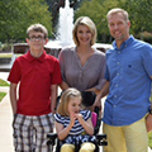Our “Love Language”

Jodi Shenal
I'm a stay-at-home mom with two amazing children. My son is on the Autism spectrum and my daughter has a rare genetic disorder and multiple disabiliti...
In our family, “I love you” is not always uttered in spoken words.
For a long time, coming to terms that with that fact was difficult for me.
In my unrelenting quest to give my nonverbal child a voice, I recently stumbled upon the most interesting notion. While watching one of several webinars on Augmentative and Alternative Communication (AAC), a concept called “love language” was discussed. As I have painstakingly researched and evaluated many different AAC methods for my nine-year-old daughter, trying to find the one best suited for her, it never dawned on me that she already has quite an extensive vocabulary. Although her words are not expressed verbally, she communicates with me, her Dad, and her brother through her very own unique language. In our family, we have clear and powerful conversations without words; the four of us share a love language that we can easily interpret.
My daughter tells us so much with her expressive eyes. She conveys excitement, happiness, and even annoyance with a simple look. Her face is telling, and we have learned to read it for clues as to how she feels.
When I wake her in the mornings, I always brush the hair out of her face. As I whisper, “Good morning, Love”, she grins sweetly, takes my hand, and holds it tight. I know that must be her way of greeting me with a “Good morning, Mama.”
Sitting with her Daddy, she studies his face carefully while babbling various sounds with inflection. The only discernible utterance is “Hey DaDa”, which she will lovingly repeat to him, over and over. She always reaches up and gently touches his face with her little hand. I never grow tired of witnessing that beautiful display of love.
There are many other ways she “tells” us, besides using her AAC app or picture board.
Climbing onto the sofa and tapping the front cover of a book lets me know that she’s ready for me to read to her.
Playfully drumming on her iPad while looking at her brother, she knows he will stop whatever he is doing, time and time again, to press play for her next episode of “Sarah and Duck.”
Deliberately shaking her head for “NO!” speaks volumes.
Crawling over to look out the glass door, knocking on it steadily, she exclaims that it’s time to go outside…NOW!
Applauding when we tell her “Good job” proclaims that she is super proud of herself.
Crawling over to me and grabbing both of my hands lets me know that she’s ready to play. She’ll instinctively bring my hands together in a clapping motion. She loves to clap and enjoys having someone to clap along with her. She watches my hands attentively, to ensure that I perform in the manner that she prefers. If my clap routine varies one bit, she will emphatically take my hands and “show me” how to do it correctly!
We will fervently continue our AAC journey. Identifying the best means of effective communication for my daughter is a crucial goal. Likely, it will be a combination of multiple AAC methods. In the meantime, I will appreciate the love language that she is already fluent in. “I love you” is not a phrase that must fall upon our ears to be loudly heard. Through nonverbal gestures, it can be felt in the most magical ways.


